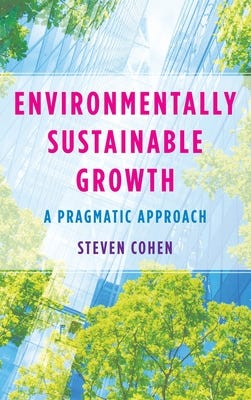Environmentally Sustainable Growth: A Pragmatic Approach
Steven Cohen
Columbia University Press 2023
216 pages
I am one of those environmentally conscious persons from the seventies who dreams of a world filled with people who live in straw bale constructed homes topped with solar panels, who forego automobiles for public transportation, who dry their clothes on old-fashioned clotheslines, recycle and compost everything, and go about their lives in other carbon-neutral ways.
I have therefore always been skeptical of the term “sustainable growth.” When people talk of such things, it seems to me that they want to have their cake and eat it, too. But Steven Cohen with his new book Environmentally Sustainable Growth: A Pragmatic Approach offers folks like me a real eye-opener. He effectively argues for supporting an economy based on growth while maintaining sustainability. He makes two key points:
One: We cannot abandon growth. People want to perceive that their lives or the lives of their children will improve. It is dangerous when people feel as though they are falling behind. Political instability is the result. According to Cohen, the potential misery that could result from such instability, a worldwide depression for example, would exceed that caused by a climate disaster.
Two: It is possible to have economic growth AND achieve a level of sustainability. Fifty years ago, smog was blindingly thick in Los Angeles and other U.S. cities. Pollution choked our waterways. Infamously, the Cuyahoga River in Ohio carried so much effluent, industrial waste, and garbage that it caught fire. Since then, however, we have cleaned up our act and much of our environment, all the while that we have enjoyed economic growth. Growth and sustainability are not necessarily incompatible.
Cohen established his bona fides in sustainability long before writing this book. Starting his career at the EPA, he developed an interest in both management and sustainable practices. He is currently the senior vice dean of the School of Professional Studies and professor of the practice of public affairs at the School of International and Public Affairs at Columbia University and serves as the director for two master’s programs at Columbia. Cohen is also the director of the Earth Institute’s Research Program on Sustainability Policy and Management.
Throughout his book Cohen offers straightforward thinking and a lot of plain common sense. Elsewhere, I’ve read pages and pages on the effectiveness and strategies of implementing a carbon tax. Reducing CO2 by making fossil fuels more expensive, a carbon tax would be simpler than a regime of emissions regulations. There are nonetheless complications in enforcing compliance and ensuring that poor people would not be overly burdened when it comes time to heat their homes. While admitting that a carbon tax may have a place in making a more sustainable world, Cohen offers an even simpler idea: just make renewable energy cheaper than the energy from natural gas, oil, and coal. Even folks wearing red MAGA hats will have little loyalty to fossil fuels if they can warm their homes and power their cars more cheaply on renewable energy sources.
Cohen embraces technology and innovation. Robotics and AI can alleviate the drudgery and hazards for those who do the hands-on work of sorting in recycle centers. Possibly due to his experience in management, Cohen also brings in other ideas that I don’t find or are poorly developed in other literature on sustainability. In the business world, everything is metrics, metrics, metrics. The same ability to measure should be applied to sustainability.
The writing style is direct, and Cohen does not adorn the chapters of this book with personal stories or profiles of individuals to put flesh and bones on an issue of sustainability or environmental problem. This “just the facts” approach allows the author to fill this thin book (216 pages, including references and index) with a great deal of information.
Still, there were times that I wished for more detail or explanation. Cohen touches on the subject of turning pig waste, a horrible, polluting problem, into a resource. But readers are not given an example of a farm that makes use of pig waste or what resources the waste offers. The author briefly mentions Leadership in Energy and Environmental Design (LEED), the green building certification developed by the United States Green Building Council, without a description or explanation of what LEED is. Perhaps the assumption was that the intended readership of this book is fully informed about LEED. Still, a brief explanation would help the more general reader without boring those who are in the know. Also, I would have appreciated Cohen’s assessment of LEED’s effectiveness and how he thinks this certification program might play a part in making a more sustainable world.
Notes on editing proofing and indexing
First of all, the proofing of this book was, to my reading, flawless. In the close to 200 pages of text I found no typos or errors in punctuation or grammar. Kudos to the proofreader. Susan McClung, the book’s copyeditor, deserves acknowledgement as well. The book is exceptionally well organized. References are conveniently at the ends of chapters, although these are only for works quoted in the book. The text is not otherwise footnoted. Indexing is comprehensive.







Very well thought out and written review. Thank you for your service.